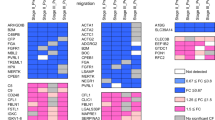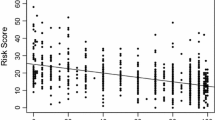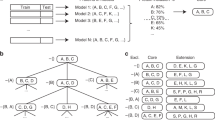Abstract
Estrogen receptor (ER)-positive/progesterone receptor (PR)-positive invasive ductal carcinoma accounts for ~45 % of invasive breast cancer (BC) diagnoses in the U.S. Despite reductions in BC mortality attributable to mammography screening and adjuvant hormonal therapy, an important challenge remains the development of clinically useful blood-based biomarkers for risk assessment and early detection. The objective of this study was to identify novel protein markers for ER+/PR+ ductal BC. A nested case–control study was conducted within the Women’s Health Initiative observational study. Pre-clinical plasma specimens, collected up to 12.5 months before diagnosis from 121 cases and 121 matched controls, were equally divided into training and testing sets and interrogated using a customized antibody array targeting >2000 proteins. Statistically significant differences (P < 0.05) in matched case versus control signals were observed for 39 candidates in both training and testing sets, and four markers (CSF2, RYBP, TFRC, ITGB4) remained significant after Bonferroni correction (P < 2.03 × 10−5). A multivariate modeling procedure based on elastic net regression with Monte Carlo cross-validation achieved an estimated AUC of 0.75 (SD 0.06). Most candidates did not overlap with those described previously for triple-negative BC, suggesting sub-type specificity. Gene set enrichment analyses identified two GO gene sets as upregulated in cases—microtubule cytoskeleton and response to hormone stimulus (P < 0.05, q < 0.25). This study has identified a pool of novel candidate plasma protein biomarkers for ER+/PR+ ductal BC using pre-diagnostic biospecimens. Further validation studies are needed to confirm these candidates and assess their potential clinical utility for BC risk assessment/early detection.


Similar content being viewed by others
References
Kerlikowske K, Grady D, Rubin SM et al (1995) Efficacy of screening mammography. A meta-analysis. JAMA 273:149–154
Nyström L, Andersson I, Bjurstam N et al (2002) Long-term effects of mammography screening : updated overview of the Swedish randomised trials. Lancet 359:909–919. doi:10.1016/S0140-6736(02)08020-0
Humphrey LL, Helfand M, Chan BK, Woolf SH (2002) Breast cancer screening: a summary of the evidence for the U.S. Preventive Services Task Force. Ann Intern Med 137:347–360
USPSTF (2009) Screening for breast cancer: U.S. Preventive Services Task Force recommendation statement. Ann Intern Med 151:716–726. doi:10.7326/0003-4819-151-10-200911170-00008 W–236
Miller AB, Wall C, Baines CJ (2014) Twenty five year follow-up for breast cancer incidence and mortality of the Canadian National Breast Screening Study: randomised screening trial. BMJ 348:g366–g366. doi:10.1136/bmj.g366
Brawley OW (2012) Risk-based mammography screening: an effort to maximize the benefits and minimize the harms. Ann Intern Med 156:662–663. doi:10.7326/0003-4819-156-9-201205010-00012
Pace LE, Keating NL (2014) A systematic assessment of benefits and risks to guide breast cancer screening decisions. JAMA 311:1327–1335. doi:10.1001/jama.2014.1398
Onega T, Beaber EF, Sprague BL et al (2014) Breast cancer screening in an era of personalized regimens: a conceptual model and National Cancer Institute initiative for risk-based and preference-based approaches at a population level. Cancer 120:2955–2964. doi:10.1002/cncr.28771
Phillips M, Beatty JD, Cataneo RN et al (2014) Rapid point-of-care breath test for biomarkers of breast cancer and abnormal mammograms. PLoS One 9:e90226. doi:10.1371/journal.pone.0090226
Lacombe J, Mangé A, Bougnoux A-C et al (2014) A multiparametric serum marker panel as a complementary test to mammography for the diagnosis of node-negative early-stage breast cancer and DCIS in young women. Cancer Epidemiol Biomark Prev 23:1834–1842. doi:10.1158/1055-9965.EPI-14-0267
Brooks M (2009) Breast cancer screening and biomarkers. Methods Mol Biol 472:307–321. doi:10.1007/978-1-60327-492-0_13
Li CI (2011) Discovery and validation of breast cancer early detection biomarkers in preclinical samples. Horm Cancer 2:125–131. doi:10.1007/s12672-010-0061-3
Zaenker P, Ziman MR (2013) Serologic autoantibodies as diagnostic cancer biomarkers–a review. Cancer Epidemiol Biomark Prev 22:2161–2181. doi:10.1158/1055-9965.EPI-13-0621
Coronell JAL, Syed P, Sergelen K (2012) The current status of cancer biomarker research using tumour-associated antigens for minimal invasive and early cancer diagnostics. J Proteomics 76:102–115. doi:10.1016/j.jprot.2012.07.022
Gong B, Xue J, Yu J et al (2012) Cell-free DNA in blood is a potential diagnostic biomarker of breast cancer. Oncol Lett 3:897–900. doi:10.3892/ol.2012.576
Ng EKO, Li R, Shin VY et al (2013) Circulating microRNAs as specific biomarkers for breast cancer detection. PLoS One 8:e53141. doi:10.1371/journal.pone.0053141
Cuk K, Zucknick M, Heil J et al (2013) Circulating microRNAs in plasma as early detection markers for breast cancer. Int J Cancer 132:1602–1612. doi:10.1002/ijc.27799
Lu H, Ladd J, Feng Z et al (2012) Evaluation of known oncoantibodies, HER2, p53, and cyclin B1, in prediagnostic breast cancer sera. Cancer Prev Res (Phila) 5:1036–1043. doi:10.1158/1940-6207.CAPR-11-0558
Pitteri SJ, Amon LM, Busald Buson T et al (2010) Detection of elevated plasma levels of epidermal growth factor receptor before breast cancer diagnosis among hormone therapy users. Cancer Res 70:8598–8606. doi:10.1158/0008-5472.CAN-10-1676
Fischer JC, Niederacher D, Topp SA et al (2013) Diagnostic leukapheresis enables reliable detection of circulating tumor cells of nonmetastatic cancer patients. Proc Natl Acad Sci USA 110:16580–16585. doi:10.1073/pnas.1313594110
Reis-Filho JS, Pusztai L (2011) Gene expression profiling in breast cancer: classification, prognostication, and prediction. Lancet 378:1812–1823. doi:10.1016/S0140-6736(11)61539-0
Eroles P, Bosch A, Pérez-Fidalgo JA, Lluch A (2012) Molecular biology in breast cancer: intrinsic subtypes and signaling pathways. Cancer Treat Rev 38:698–707. doi:10.1016/j.ctrv.2011.11.005
Bao P-P, Shu XO, Gao Y-T et al (2011) Association of hormone-related characteristics and breast cancer risk by estrogen receptor/progesterone receptor status in the shanghai breast cancer study. Am J Epidemiol 174:661–671. doi:10.1093/aje/kwr145
Yang XR, Chang-Claude J, Goode EL et al (2011) Associations of breast cancer risk factors with tumor subtypes: a pooled analysis from the Breast Cancer Association Consortium studies. J Natl Cancer Inst 103:250–263. doi:10.1093/jnci/djq526
Pestalozzi BC, Zahrieh D, Mallon E et al (2008) Distinct clinical and prognostic features of infiltrating lobular carcinoma of the breast: combined results of 15 International Breast Cancer Study Group clinical trials. J Clin Oncol 26:3006–3014. doi:10.1200/JCO.2007.14.9336
Desantis C, Ma J, Bryan L, Jemal A (2014) Breast cancer statistics, 2013. CA Cancer J Clin 64:52–62. doi:10.3322/caac.21203
Li CI, Mirus JE, Zhang Y et al (2012) Discovery and preliminary confirmation of novel early detection biomarkers for triple-negative breast cancer using preclinical plasma samples from the Women’s Health Initiative observational study. Breast Cancer Res Treat 135:611–618. doi:10.1007/s10549-012-2204-4
Hays J, Hunt JR, Hubbell FA et al (2003) The Women’s Health Initiative recruitment methods and results. Ann Epidemiol 13:S18–S77
Study, The Women’S Health Initiative (1998) Design of the Women’s Health Initiative clinical trial and observational study. Control Clin Trials 19:61–109
Loch CM, Ramirez AB, Liu Y et al (2007) Use of high density antibody arrays to validate and discover cancer serum biomarkers. Mol Oncol 1:313–320. doi:10.1016/j.molonc.2007.08.004
Ramirez AB, Loch CM, Zhang Y et al (2010) Use of a single-chain antibody library for ovarian cancer biomarker discovery. Mol Cell Proteomics 9:1449–1460. doi:10.1074/mcp.M900496-MCP200
Mirus JE, Zhang Y, Li CI et al (2015) Cross-species antibody microarray interrogation identifies a 3-protein panel of plasma biomarkers for early diagnosis of pancreas cancer. Clin Cancer Res 21:1764–1771. doi:10.1158/1078-0432.CCR-13-3474
Ritchie ME, Silver J, Oshlack A et al (2007) A comparison of background correction methods for two-colour microarrays. Bioinformatics 23:2700–2707. doi:10.1093/bioinformatics/btm412
Smyth GK, Speed T (2003) Normalization of cDNA microarray data. Methods 31:265–273
Friedman J, Hastie T, Tibshirani R (2010) Regularization paths for generalized linear models via coordinate descent. J Stat Softw 33:1–22
Sing T, Sander O, Beerenwinkel N, Lengauer T (2005) ROCR: visualizing classifier performance in R. Bioinformatics 21:3940–3941. doi:10.1093/bioinformatics/bti623
The Cancer Genome Atlas Research Network (2011) Integrated genomic analyses of ovarian carcinoma. Nature 474:609–615. doi:10.1038/nature10166
The Cancer Genome Atlas Research Network (2012) Comprehensive molecular portraits of human breast tumours. Nature 490:61–70. doi:10.1038/nature11412
Rho JH, Mead JR, Wright WS et al (2014) Discovery of sialyl Lewis A and Lewis X modified protein cancer biomarkers using high density antibody arrays. J Proteomics 96:291–299. doi:10.1016/j.jprot.2013.10.030
Zou H, Hastie T (2005) Regularization and variable selection via the elastic net. J R Stat Soc Ser B (Statistical Methodol) 67:301–320. doi:10.1111/j.1467-9868.2005.00503.x
Habashy HO, Powe DG, Staka CM et al (2010) Transferrin receptor (CD71) is a marker of poor prognosis in breast cancer and can predict response to tamoxifen. Breast Cancer Res Treat 119:283–293. doi:10.1007/s10549-009-0345-x
Miller LD, Coffman LG, Chou JW et al (2011) An iron regulatory gene signature predicts outcome in breast cancer. Cancer Res 71:6728–6737. doi:10.1158/0008-5472.CAN-11-1870
Lu S, Simin K, Khan A, Mercurio AM (2008) Analysis of integrin beta4 expression in human breast cancer: association with basal-like tumors and prognostic significance. Clin Cancer Res 14:1050–1058. doi:10.1158/1078-0432.CCR-07-4116
Diaz LK, Cristofanilli M, Zhou X et al (2005) Beta4 integrin subunit gene expression correlates with tumor size and nuclear grade in early breast cancer. Mod Pathol 18:1165–1175. doi:10.1038/modpathol.3800411
Lipscomb EA, Simpson KJ, Lyle SR et al (2005) The alpha6beta4 integrin maintains the survival of human breast carcinoma cells in vivo. Cancer Res 65:10970–10976. doi:10.1158/0008-5472.CAN-05-2327
Dutta U, Shaw LM (2008) A key tyrosine (Y1494) in the β4 integrin regulates multiple signaling pathways important for tumor development and progression. Cancer Res 68:8779–8787. doi:10.1158/0008-5472.CAN-08-2125
Beguin Y, Huebers HA, Josephson B, Finch CA (1988) Transferrin receptors in rat plasma. Proc Natl Acad Sci USA 85:637–640
Desgrosellier JS, Cheresh DA (2010) Integrins in cancer: biological implications and therapeutic opportunities. Nat Rev Cancer 10:9–22. doi:10.1038/nrc2748
Bon G, Folgiero V, Di Carlo S et al (2007) Involvement of alpha6beta4 integrin in the mechanisms that regulate breast cancer progression. Breast Cancer Res 9:203. doi:10.1186/bcr1651
Chen S-T, Pan T-L, Juan H-F et al (2008) Breast tumor microenvironment: proteomics highlights the treatments targeting secretome. J Proteome Res 7:1379–1387. doi:10.1021/pr700745n
Anderson KS, Sibani S, Wallstrom G et al (2011) Protein microarray signature of autoantibody biomarkers for the early detection of breast cancer. J Proteome Res 10:85–96. doi:10.1021/pr100686b
Hanash SM, Taguchi A (2014) Mouse to human blood-based cancer biomarker discovery strategies. Cold Spring Harb Protoc 2014:144–149. doi:10.1101/pdb.top078808
Pascal LE, True LD, Campbell DS et al (2008) Correlation of mRNA and protein levels: cell type-specific gene expression of cluster designation antigens in the prostate. BMC Genom 9:246. doi:10.1186/1471-2164-9-246
Acknowledgments
This work was principally supported by NIH grant U01CA152637 (C.I.L) and NIH training grant T32CA009168 (M.F.B).
Author information
Authors and Affiliations
Corresponding authors
Electronic supplementary material
Below is the link to the electronic supplementary material.
Rights and permissions
About this article
Cite this article
Buas, M.F., Rho, Jh., Chai, X. et al. Candidate early detection protein biomarkers for ER+/PR+ invasive ductal breast carcinoma identified using pre-clinical plasma from the WHI observational study. Breast Cancer Res Treat 153, 445–454 (2015). https://doi.org/10.1007/s10549-015-3554-5
Received:
Accepted:
Published:
Issue Date:
DOI: https://doi.org/10.1007/s10549-015-3554-5




